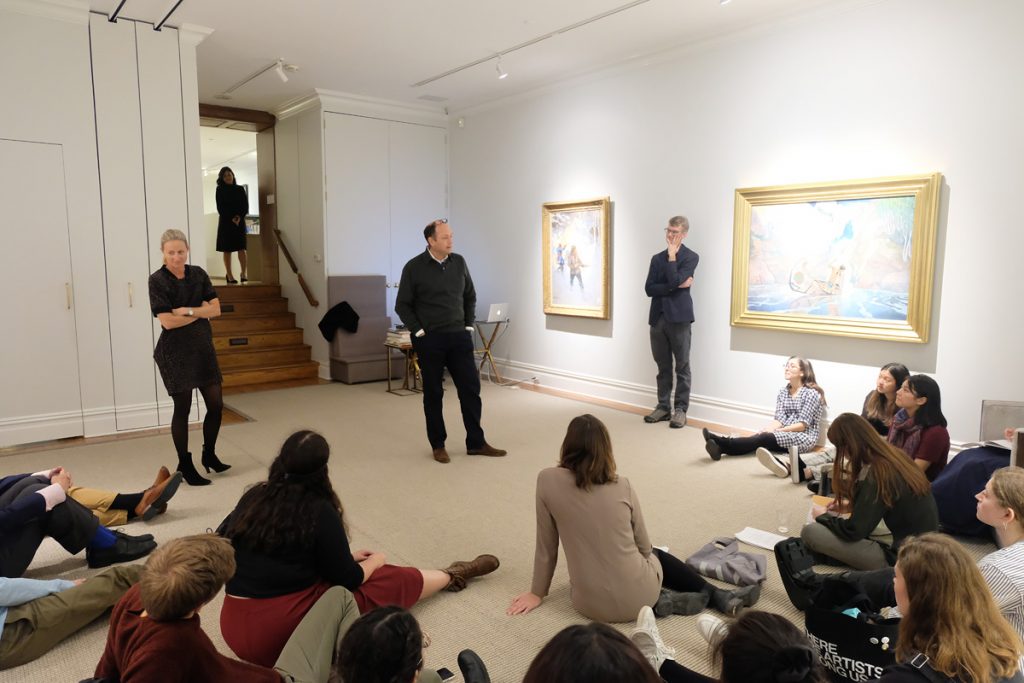Andy Schoelkopf, Director, Menconi & Schoelkopf Fine Art
By Adriana Mullin ’21
The trip to New York City not only cemented many of the concepts from class, such as the business of selling art, the value of modern art, and the role of museums in reality for me, it also changed many of the preconceived opinions and ideas about the art world that I had before the trip. Our visit and interview with Andy Schoelkopf, the owner of Menconi + Schoelkopf Fine Art Gallery most drastically changed my expectations of both art galleries and the role of art dealers.

Schoelkopf in his discussion focused on his strong devotion to honesty and transparency in the running of his business. As Schoelkopf mentioned, the public perception of art dealers and auction houses is often very negative because of their ambiguous nature to those not directly in contact with the art world. Art dealers are often thought of as manipulative and solely economically focused. I shared similar views because I had no experience with art dealing, but my opinions changed drastically after my experiences this weekend and conversation with Schoelkopf.
Inspired by the highly regarded and trusted gallery his father owned, Schoelkopf sought to do the same when he opened his own gallery. Schoelkopf provides transparency through education, and because of that, the gallery has never suffered from a public crisis as have many other galleries. What stood out to me most was Schoelkopf’s method of educating his clients. He shows a wide array of works and grades them built on a foundation of understanding the art object and its history. This was very impactful for me, because I often have a hard time determining what makes a work of art better than another, or ‘great.’ His description of part of the gallery’s ambition to study the history of a piece, including the artist’s state during the time of its creation, as well as the public’s perception during the time of the creation of the work, were ways to value a work of art I had never thought of before. His minimalist exhibition of Andrew Wyeth’s ‘great’ works of art in the gallery helped to cement the idea of the value of looking at art as an object and having smaller works and less valuable works available to compare them to as needed to help show a client the value of those on the wall. I was particularly pleased by Schoelkopf’s discussion of maintaining their personal criteria for the value of an art work when helping families sell or acquire works, while incorporating the families’ main goals, rather than trying to quickly sell a piece as I had assumed was the main ambition of dealers.
Another element of our conversation with Schoelkopf that stood out was his and the gallery’s drive to help museums. It changed my opinion of dealers’ financial focus; the gallery’s efforts to help the Philadelphia Museum of Art and the Pennsylvania Academy of the Fine Arts acquire The Gross Clinic by Thomas Eakin clearly demonstrated Schoelkopf’s honest ambitions. Schoelkopf discussed how he recognized the historical importance of the painting to Philadelphia and helped the museums there create a plan to acquire it, rather than letting it be purchased by a private buyer, which would have taken much less effort and time and resulted in greater remuneration.
I was inspired by Schoelkopf’s love of American art and it showed me the importance of not only studying such work, but the power of looking at it and viewing it as 3D objects with unique histories. This conversation in particular showed me the importance of a class such as this one and the impact American art has in the real world on a day to day basis. However, it also made me slightly sad, as Schoelkopf is one of the few galleries solely dedicated to Modern American Art.